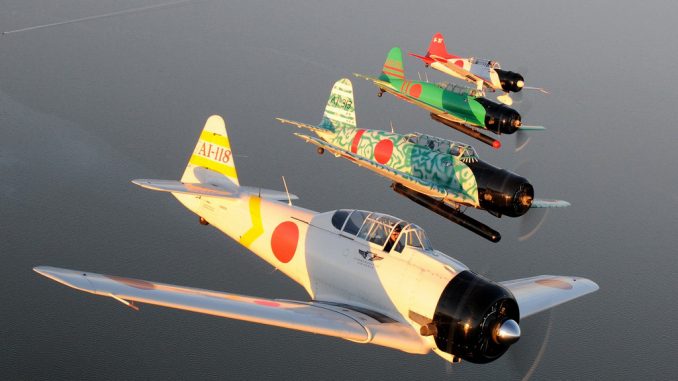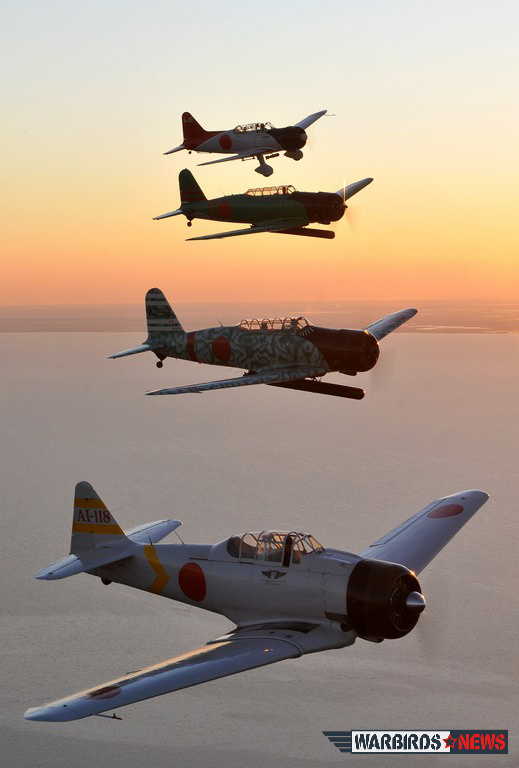
By Luigino Caliaro, translated by Frank McMeicken and edited by WarbirdsNews
Hawaii – Sunday December 7th, 1941 – the sky was clear, the temperature mild, and a light sea breeze was blowing. Breakfast was on the tables in many homes, while activity was slowly commencing at military scattered around the islands. Suddenly, a formation of inbound aircraft arrived from the North and broke the quiet of that peaceful Hawaiian morning. Aboard one of these naval aircraft bearing the symbols of the Empire of Japan, Commander Fuchida Mitsuo transmitted the famous war cry “Tora, Tora, Tora” to his leader back in the Imperial Japanese Fleet, Vice Admiral Chuiki Nagumo. Meaning “Tiger, Tiger, Tiger” in Japanese, the phrase indicated that Mitsuo’s airborne force had achieved a successful surprise attack. Those words would become the symbol for the outbreak of WWII in the Pacific.
Even today, these three simple words remain associated with those tragic moments, and are recalled and re-lived during the most important air displays held throughout America thanks to the participation of the “TORA TORA TORA” display team. This is a group of civilian pilots who, with aircraft modified to resemble the Zeros, Vals and Kates of the Japanese attacking force, participate each year in more than fifteen air displays across the USA. They attempt to reproduce an eighteen minute spell of the Japanese attack on Pearl Harbor and its surroundings.
We met with Mark Allen, the Tora Tora Tora team’s leader, sheltered from the baking Texas sun beneath the wing of a Zero marked AI-118, while the squadron awaited the rehearsal time for one of their displays. Allen explained that the idea behind creating the team, how they conceived it, and how they modified the aircraft to best represent the attackers.
“Everything came about in 1968,” related Allen, “when 20th Century Fox began the production of TORA TORA TORA, the colossal movie that Hollywood dedicated to the attack on Pearl Harbor. For the flying shots, the producer Elmo Williams and the two directors of filming, Richard Fleisher and Akira Kurasawa, quickly tackled the problem of recreating, in the most faithful way possible, the Japanese fighters involved in the attack, discounting the possibility of using American aircraft wearing Japanese insignia in consideration of the fact that the flying sequences were the most important parts of the movie. As they were unable to use original Japanese aircraft due to the simple fact that there were no survivors in flying condition, 20th Century Fox set about identifying a possible solution, which was found thanks to the collaboration of Jack Canary and Lynn Garrison. Canary, in fact, had already previously worked with the producer, Elmo Williams, constructing the two Fokker Triplanes used in the film “The Blue Max”, and [they] decided to recreate the three types of Japanese aircraft used in the attack: the Mitsubishi Zero Carrier Fighter (A6M), Nakajima Type 97 ‘Kate’ Carrier Attack Bomber (B5N), and the Aichi 99 ‘Val’ Carrier bomber (D3A).”
The Americans code named these aircraft Zero or Zeke for the fighter, Kate for the Type 97 torpedo bomber and Val for the Type 99 dive bomber. The Japanese military designated their aircraft by type number, based on the last two digits of the Japanese calendar year when the aircraft entered service. The type Zero fighter gained its name because it entered service in the Japanese calendar year 2600 (our 1940), the Type 97 torpedo bomber in 2597 (our 1937) and the Type 99 dive bomber in year 2599 (1939). Captain Frank T. McCoy Jr., intelligence officer of the 38th Bomb Group and his staff came up with the American code names. They formulated their system in Australia during early 1942. They chose boy’s names for fighters, and girl’s names for bombers; hence Zeke, Kate and Val. The name Zero remained in Allied use for the fighter simply because it was already too familiar and popular by 1942.
To ensure the most faithful reproduction of these aircraft, Canary decided to base them upon two of the most readily available American WWII training aircraft; the Vultee BT-13 basic trainer and the North American AT-6 advanced trainer. As soon as 20th Century Fox signed the construction contract, Canary, together with Lynn Garrison, a former RCAF pilot, acquired their first aircraft. They sent them for modification at two separate workshops; one at Long Beach, Stewart-Davis and the other at Cal-Volair. The modifications encountered numerous problems. The Zero replica, for example, required the AT-6 undergo numerous changes, particularly around the cockpit and tail areas.



– I like very much, this kind, of flying !
– Hugs !